
Cheetah

The cheetah is peculiar among all the species of cats. Although not as powerful as other large cats, their long graceful bodies give them a regal, aristocratic look. In both looks and agility they are more like powerfully built hound dogs. The cheetah does not roar, but it does purr and other vocal sounds range from high pitched yelps and barks to longer chirruping sounds. The cheetah was formerly trained and used for hunting in Asia, Libya, and India; it is now extinct or endangered in much of its range.
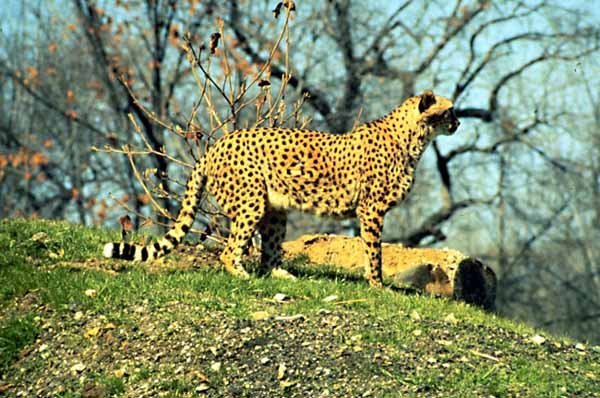 APPEARANCE
APPEARANCE
The cheetah has a small head, high-set eyes, and small rather flattened ears.
The cheetah's long skull, large nasal passages, and large lungs help it to breathe when running.
Its streamlined body is carried on long, thin, powerful legs, which give it the ability to achieve great speed in the chase. A fully-grown cheetah can reach speeds of up to 70 miles per hour in 2 to 3 seconds, and maintain it for 1000 feet. It can easily outrun any animal over short distances.
Its paws are also dog-like. They are narrow and have hard pads with grooves for better traction at high speeds. Unlike all other cat species their claws are only slightly retractable and are short and lack the sheath that covers retracted claws in other cat species. This adaptation gives the cat extra grip when running.
The cheetah's long tail acts as a balance and aids in high-speed turns.
The coat is yellowish-brown with black spots; cubs also have a spotted coat, but over the back and head is a mantle of long, silky, gray hair that remains for up to four months.
The face is marked by a
conspicuous 'tear stripe' running from the corner of the eyes down
the side of the nose.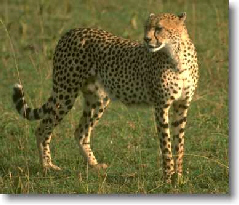 These tear lines probably serve the same purpose as a football
player's black face grease - to help reduce the sun's glare.
These tear lines probably serve the same purpose as a football
player's black face grease - to help reduce the sun's glare.
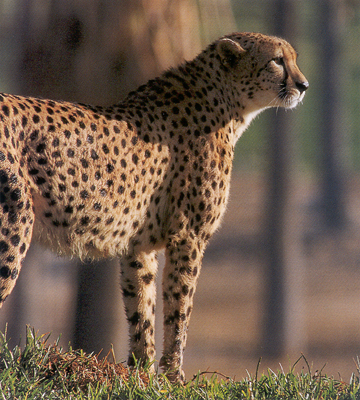 Adult
cheetahs range from 110 to 130 pounds. The head and body, without
the tail, are about 3.6 to 4.9 feet long. Males are usually slightly
larger than females
Adult
cheetahs range from 110 to 130 pounds. The head and body, without
the tail, are about 3.6 to 4.9 feet long. Males are usually slightly
larger than females
THE HUNT
The cheetah's hunting technique has been adapted to suit its speed and agility and unlike many other wild cats it hunts mainly by day relying on acute eyesight. It will follow its prey from a distance, commonly the large herds of gazelle, impala or antelope, selecting old, injured or young animals, who's speed will be impaired. Once its pray is selected, the cheetah will give chase. Chases are successful about half the time and rarely exceed one minute in length.
The cheetah's powerful jaw
muscles enable it to grip its prey, without  pause,
for several minutes and it uses this to suffocate its catch by
clamping the windpipe. Cheetahs always kill their prey with a bite to
the neck. Compared to other species of wildcat, the cheetah has
enlarged nasal passages that enable it to breathe more easily during
this final phase of the kill.
pause,
for several minutes and it uses this to suffocate its catch by
clamping the windpipe. Cheetahs always kill their prey with a bite to
the neck. Compared to other species of wildcat, the cheetah has
enlarged nasal passages that enable it to breathe more easily during
this final phase of the kill.
Once the kill has been made the cheetah will pause to regain its strength before eating. At this time the cheetah itself is vulnerable and frequently loses its prey to packs of hyenas or to other scavengers of the open plains.
Male cheetahs will hunt alone or in family groups called a coalition. Such groups usually have much larger territories than the lone female hunter who must stay close to her young. Females hunt alone but will hunt with their nearly grown cubs until they are old enough to hunt alone.
REPRODUCTION
There is no regular breeding season and cubs are born in all months of the year. Sexual maturity occurs at about 2 years old. Usually, only the dominant male of an area mates with receptive females. After a gestation period of about 95 days, the female gives birth to two to eight cubs but the average litter is three.
Cheetah cubs have a poor survival rate, commonly falling prey to lions, leopards or packs of hyenas. To protect the cubs, the mother carries the cubs to a new hiding place everyday. When the cubs are 5-6 weeks old, they are able to follow their mother and eat from prey she catches. After approximately 15 to 18 months of following and learning from its mother, a young cheetah is ready to fend for itself.
LIFE SPAN
In the wild, cheetahs that survive infancy usually live from twelve to seventeen years.
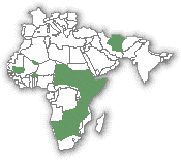 RANGE
RANGE
Once the cheetah's range ran from India, through the Middle East and extended to the very south of the African continent. Today the Asian cheetah is almost extinct and can only be found in a few remote areas of Iran and Afghanistan. In Africa, with the spread of the human influence and exploitation in hunting, the cheetah's range has shrunken dramatically - now only the grasslands and plains of east and central Africa are home to its dwindling numbers.

STATUS
Roughly ten thousand years ago a genetic bottleneck occurred when most of the cheetahs were wiped out by dramatic climate changes. Today any two cheetahs are as closely related as identical twins. All cheetahs share 99% of the same genes and are thus extremely susceptible to disease and genetic defects. This also lessens its ability to cope with changes in its environment. The cheetah has one of the lowest degrees of genetic diversity among all mammals. Genetic variation between cheetahs is so low that a given animal will not recognize the difference when a tissue graft from another cheetah surgically replaces its own tissue. Scientists hope to use modern captive breeding programs to increase genetic diversity in the species.
KING CHEETAH
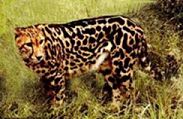
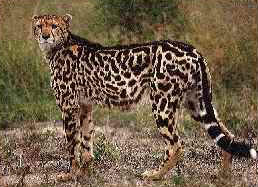
Although there is little physical difference, apart from a slight size variation, between the African and Asian cheetahs, the King Cheetah displays a rare fur pattern mutation. Once believed to be a sub-species, the king cheetah has longer fur on the back of the head and neck, resembling a mane, as well as elongated spots which join to form long irregular markings along its back. It is now believed that this difference in markings is a result of a recessive gene and a king cheetah and normally marked cheetah have been reported in the same litter. However sightings of the king cheetah have been restricted in location, to Zimbabwe, Botswana and in the northern part of South Africa's Transvaal province. A recessive gene must be inherited from both parents in order for this "blotchy" pattern to appear. First discovered in Zimbabwe in 1926, this very rare animal has been seen in the wild only 6 times. The DeWildt Cheetah Research Centre in South Africa specializes in breeding this cat in captivity.
FURTHER READING
http://www.geocities.com/rainforest/vines/9244/cheetah.html